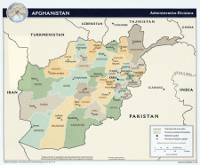Coalition and Afghan special operations forces captured a senior terrorist leader during a night raid yesterday in the northern Afghan province of Kunduz.
The senior Islamic Movement of Uzbekistan leader, who was not named, “attempted to disguise himself as a female by wearing a burka, which is an all-enveloping cloak worn by some Muslim women,” the International Security Assistance Force noted in a press release. He was captured along with two of his aides.
The IMU commander “facilitated suicide bomb operations and coordinated attacks against other Afghan security forces,” and “also supported the Taliban network,” ISAF stated.
ISAF and Afghan special operations forces have focused considerable efforts against the IMU. Of the eight raids against terror groups directly allied with al Qaeda that were reported by ISAF this month, seven targeted the IMU. Three of those raids took place in Kunduz, two in the neighboring province of Baghlan, one in Balkh in the northwest, and one in Zabul in the southeast.
In April, ISAF and Afghan forces captured the IMU’s top leader in Afghanistan. The unnamed IMU leader escaped from a jail in Pakistan sometime in 2010 and entered Afghanistan shortly afterward. The captured IMU leader served as “a key conduit between the senior IMU leadership in Pakistan and senior Taliban leadership in Afghanistan,” ISAF stated.
Background on terrorist havens in the north
ISAF has begun to identify the location of safe havens and training camps in the north for the Taliban and the allied Islamic Movement of Uzbekistan. Both terror groups maintain a strong presence in the northern Afghan provinces of Badakhshan, Baghlan, Balkh, Faryab, Jawzjan, Kunduz, Samangan, Sar-i-Pul, and Takhar, and have established suicide and military training camps in the north over the past several years. As the two groups expand their presence in the north, top leaders of the Islamic Movement of Uzbekistan have integrated into the Taliban’s shadow government in the northern provinces.
ISAF has identified the presence of camps in Sar-i-Pul and Samangan provinces. On March 22, the special operations team captured an IMU commander who ran camps in Samangan.
The IMU has also established camps in Kunduz province, a Taliban commander from Baghlan named Mustafa told the Asia Times. The Taliban commander said that jihadis from Central Asia, including “Chechnya, Uzbekistan, Tajikistan, and Russia,” make up a significant portion of the fighters in the the Afghan north and that they are setting their sights on the neighboring country of Uzbekistan.
“I can tell you that there is an active connection between the Central Asian command and the Taliban in northern Afghanistan and they often join us, but how they connect, this is beyond my level,” Mustafa told Asia Times. “Our superior commanders are in touch with their counterparts in Central Asia and if somebody arrives in Afghanistan or goes to Central Asia from Afghanistan, it is arranged at a senior leadership level.”
In late January 2011, Afghan police in Kunduz said they were looking for 15 Chechen women in the northern Afghan province who are aiding the Taliban. The women are either serving as nurses or “are experts in making roadside bombs and suicide vests.”
The IMU in Pakistan
The IMU’s leadership cadre is based in Pakistan’s Taliban-controlled tribal agency of North Waziristan, and operates primarily along the Afghan-Pakistani border and in northern Afghanistan. According to one estimate, more than 3,000 Uzbeks and other Central Asian fighters are sheltering in North Waziristan.
Between September 2010 and January 2011, the US ramped up airstrikes against the terror groups in North Waziristan. Many of the strikes targeted cells run by the Islamic Jihad Group, an IMU offshoot, which were plotting to conduct Mumbai-styled terror assaults in Europe. A Sept. 8 strike killed an IJG commander known as Qureshi, who specialized in training Germans to conduct attacks in their home country.
In South Waziristan, the IMU’s former leader, Tahir Yuldashev, was killed in a US Predator airstrike in September 2009. Yuldashev sat on al Qaeda’s top council, the Shura Majlis. He has been replaced by Abu Usman Adil.
Islamic Movement of Uzbekistan fighters often serve as bodyguards for top Pakistani Taliban and al Qaeda leaders. The IMU fights alongside the Taliban in Pakistan and Afghanistan, and has stepped up attacks in Central Asian countries as well.









4 Comments
Bill,
Is there anything to the reports of a drone being shot down in Kapisa Province ? Do the taliban have and are they using shoulder fired sam’s ? Are they coming from Iran ? How many aircraft have been lost to them ?
The women are “are experts in making roadside bombs and suicide vests.”
I wonder how this effects their marriage prospects.
Bill,
Any updates on Ilyas Kasmirir? Is the dude dead or what?
If we capture these “commanders” dressed as women, why are we not circulating pictures of them in their “dresses”, Gawd, that would be a blow to them and others within their movements. Hard to be a mean fighting machine when you’re a male dressed as a woman.